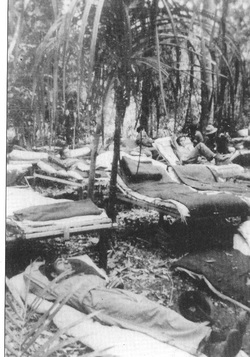|
Nine hours after the surprise attack on Pearl Harbor, Dec. 7, 1941, Japanese forces bombed the Philippines. Ninety-nine American military nurses served at hospitals there. These woman, unique to their time, had chosen the un-ladylike job of nursing and further sought a life of adventure in the Army and Navy. But they never expected what happened at lunchtime December 8, 1941.
Dozens of US fighters and bombers sat wingtip to wingtip on the tarmac at Clark Air Field when diving, screaming Japanese fighters attacked, destroying all but seven aircraft in less than an hour. The strafing flattened barracks, hangars, and machine shops. Fire engulfed the oil dump and blazed around the perimeter. Off-duty nurses ran through the smoke and flying shrapnel to treat the wounded and dying. Pieces of crumpled, blazing aircraft scattered Fort Stotsenburg and Clark Air Field. The eighty-seven army and twelve navy nurses had no military training. Nothing had prepared them for the sights, sounds and smells of war. They learned by fire—the medicine of trauma and triage. As the Japanese marched on Manila, Lieutenant Frances Nash destroyed paperwork to keep it from enemy hands. As US troops retreated into the jungle of the Bataan Peninsula, Frances was ordered to prepare to be taken prisoner by the enemy. She and a handful of other nurses stayed in Manila to treat the wounded left behind. When Frances and her staff finally got orders to flee, she stuffed her pockets with medical supplies and took enough morphine for a lethal dose for each of her nurses. They hid it in their hair, a last resort against an enemy known to rape and murder prisoners. Frances and her sister nurses would endure hardship almost beyond belief in the combat, surrender and imprisonment to come. Some people find it exciting to start a new writing project. Not me. I would much rather tackle revision.
In the beginning—anything can happen. Anything. Just the thought of sitting down and beginning causes a little flutter in my stomach, a breathlessness in my throat. I know it’s fear. Fear that has the power to stop me cold. Fear whispering in a thousand voices, all in my own mind. Once upon a time I tried to reason with this fear. I tried to argue with it, to threaten it, wrestle it, ignore it, outlast it. I tried with all my mind and heart to overcome it. I could not make fear go away. Then I learned fear is a cat. When it purrs in my ear and rubs it’s back against my leg, I smile. “Hello, Kitty,” I say, and reach down and pet the cat. “I see you. I know who you are and where you come from.” The cat lays back its ears. I give its head a little scratch. “Don’t mind me,” I say. “I’m starting a new story.” The cat curls at my feet and goes to sleep. |
I'm fascinated to discover little-known history, stories of people and events that provide a new perspective on why and how things happened, new voices that haven't been heard, insight into how the past brought us here today, and how it might guide us to a better future.
I also post here about my books and feature other authors and their books on compelling and important historical topics. Occasionally, I share what makes me happy, pictures of my garden, recipes I've made, events I've attended, people I've met. I'm always happy to hear from readers in the blog comments, by email or social media. Archives
September 2023
Categories
All
|

